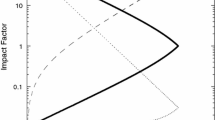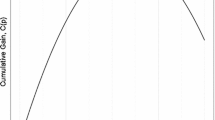Abstract
A mathematical, axiomatic definition for the hitherto vague notion of “impact measure” is proposed. For this four conditions are defined on a given set of (rank-frequency) functions (of which the aim is to measure impact). The most typical condition explains how an impact measure should behave on the most productive sources appearing in this function (i.e. in the left side of this rank-frequency function). An overview of “classical” impact measures is provided and it is proved (in most but not in all cases) that they satisfy these conditions for impact measures. This approach can be compared with (but is different from) the approach in econometrics where one defines what concentration is for a (rank-frequency) function. In this way I embed the important notion of impact into the important Lorenz theory.




Similar content being viewed by others
References
Allison, P. D. (1978). Measures of inequality. American Sociological Review, 43(6), 865–880.
Egghe, L. (2005). Power laws in the information production process: Lotkaian informetrics. Elsevier. ISBN: 0-12-088753-3.
Egghe, L. (2009). An econometric property of the g-index. Information Processing & Management, 45(4), 484–489.
Egghe, L. (2021). A theory of pointwise defined impact measures. Journal of Informetrics (to appear)
Egghe, L., & Rousseau, R. (2008). An h-index weighted by citation impact. Information Processing & Management, 44(2), 770–780.
Egghe, L., & Rousseau, R. (2019). Solution by step functions of a minimum problem in L2 [0, T], using generalized h- and g-indices. Journal of Informetrics, 13(3), 785–792.
Harter, S. P., & Nisonger, T. E. (1997). ISI’s impact factor as misnomer: A proposed new measure to assess journal impact. Journal of the American Society for Information Science, 48(12), 1146–1148.
Jin, B. H. (2006). H-index: An evaluation indicator proposed by a scientist. Science Focus, 1(1), 8–9. (in Chinese).
Jin, B. H., Liang, L. M., Rousseau, R., & Egghe, L. (2007). The R- and AR-indices: Complementing the h-index. Chinese Science Bulletin, 52(6), 855–863.
Kosmulski, M. (2006). A new Hirsch-type index saves time and works equally well as the original index. ISSI Newsletter, 2(3), 4–6.
Rousseau, R., Egghe, L., & Guns, R. (2018). Becoming Metric-wise: A Bibliometric Guide for Researchers. Chandos (Elsevier).
Acknowledgements
The author thanks Ronald Rousseau for helpful discussions, and Li Li (National Science Library, CAS) for making the figures.
Author information
Authors and Affiliations
Corresponding author
Rights and permissions
About this article
Cite this article
Egghe, L. Impact measures: What are they?. Scientometrics 127, 385–406 (2022). https://doi.org/10.1007/s11192-021-04053-3
Received:
Accepted:
Published:
Issue Date:
DOI: https://doi.org/10.1007/s11192-021-04053-3




